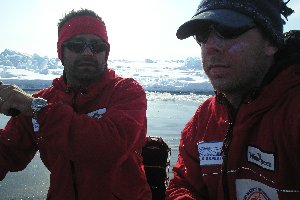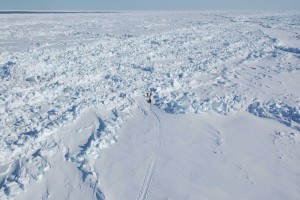May 21, 81 31.20'N:99 12.76'E

Our sunglasses are working great, even more so now with the 1/16" of frozen sleet that accumulated on our lenses. Just when we thought it couldn't get worse, it did. Our word to describe our surroundings today: bleak. However, we managed to cover a little over 6 miles nonetheless.
It was difficult at best to see today and the sleet we ran into this afternoon was bad. It was another backbreaking day on the Arctic Ocean. For us now, forward is the only way home.
Listen to today's audio update for the rest of the story.
May 20, 81 24.25'N:99 28.26E

Today, it seemed as if all the Arctic had taken a break from trying to prevent our success. Sure, there were the usual awful pressure ice and semi-frozen leads, but at least today was sunny and calm, a first. We spent the whole morning trying to avoid leads, but ended up catamaranning our boats and paddling across four of them. Of course, most were semi-frozen which really slowed us down.
Another first for us today was traveling on our Asnes skis. They worked great and we were able to make good time during the second half of the day. Up until this point we have been wearing our MSR snowshoes, and without them we would still be at the Cape. Both skis and snowshoes are proving to be critical to our ability to travel.
The nice weather definitely improved our attitudes. Yesterday we were freezing in a snowstorm, today we baked in the intense sunlight. But remember, this is the Arctic and all that can change quickly. In fact, it's now snowing again and cloudy.
Today was a good day, even though we only made 3.5 miles: it was forward progress and for right now that is one of the only ways we can measure our daily success.
May 19, 81 19.19'N:99 10.11'E

Inhospitable - that's the best word we've found to describe the Arctic - at least for us. Polar bears may feel otherwise, but we've already had too many encounters with those.
Today was our best travel day to date. We covered almost 7 miles, much of it in blowing snow. Most times, when we climbed a pressure ridge to scope the route, we couldn't see more than 100 meters. Get the full story in today's audio update.
May 18

As you may know, we are partnered with the University of Maine's Climate Change Institute. The snow samples we collect will be used to measure changes that are occurring in the chemistry of the Arctic atmosphere, as well as climate change. Upon our return, the samples will be analyzed for "major ions," oxygen and hydrogen isotopes, and trace metals. Photo courtesy Rolex/Marc Latzel.
Each night, while Lonnie's cooking and getting the tent ready, I take a few minutes to collect snow. My routine goes like this:
1. Label whirl pack with latitude, longitude & date.
2. Wearing gloves and mask I approach site from downwind.
3. Clean scoop by plunging into snow.
4. Fill whirlpack with snow.
5. Melt snow and pour into 2 pre-cleaned vials.
6. Go back to tent and have a warm drink that Lonnie's prepared.
May 17, 81 10.28'N:98 34.51E

Ice conditions are horrible and there are leads everywhere. We both fell through bad ice today. We also managed to make some northerly progress, about a mile and a half, but will be surprised if it isn't erased by morning. Still, we are getting better at traveling more efficiently. More info in today's audio update.
